
07 Jul Tracing Minds: Unfolding the Layers of Thought in The Notebook
Unfolding Creativity Through Pages: A Review of The Notebook: A History of Thinking on Paper by Roland Allen
There’s something undeniably magical about the act of writing by hand, isn’t there? The scratch of ink against paper, the chance to pause and reflect—that tactile connection transports us to a space brimming with creativity and contemplation. That’s why I was drawn to The Notebook: A History of Thinking on Paper by Roland Allen. This book promises not just a historical narrative but an exploration into how something so humble—a notebook—can shape our thoughts and lives.
In The Notebook, Allen takes us on an intoxicating journey through time. The book is crafted as a mosaic of fascinating anecdotes and insights, covering figures like Leonardo da Vinci and Marie Curie, alongside everyday heroes like cooks and sailors. What struck me particularly was the way he traced the evolution of notebooks from simple sketches to the pivotal tools behind groundbreaking theories like Darwin’s evolution and Agatha Christie’s crime plots. Each story serves as a reminder that the act of capturing thoughts—no matter how mundane or grand—can lead to significant discoveries and artistic expressions.
One of the remarkable aspects of Allen’s writing is its accessibility; he weaves historical narratives with a conversational tone that makes the text feel like a chat with an old friend. The pacing is just right—it felt both leisurely enough to let ideas sink in and brisk enough to keep the pages turning. The author’s enthusiasm for the subject is infectious, leaving me eager to pick up my own notebook and contribute to that rich tradition of thinkers and creators.
What resonated with me were Allen’s reflections on the contemporary significance of jotting things down in an age dominated by screens and digital overload. He beautifully articulates how writing by hand can enhance clarity and foster genuine understanding in a distracted world. I found the discussion of how bullet journaling can provide structure and how personal diaries can aid in healing deeply moving. It’s a testament to the quiet power of a simple notebook.
"These pages are not just blank spaces; they are opportunities," Allen suggests in one of his passages. It’s an idea that lingered with me long after I closed the book. It inspired me to rethink the relationship I have with my own notebooks—those spaces filled with dreams, to-do lists, and stray thoughts. The central theme that emerged for me was the crucial interplay between thinking and writing. As Allen reminds us, notebooks are more than just stationery; they are arenas for our most profound thoughts.
The Notebook is a treasure for anyone who has ever felt the urge to write, draw, or organize their thoughts. Whether you’re a student, a professional, or simply curious about the history of everyday objects, there’s something for you here. For those of us who cherish the tactile feel of pen and paper, Allen’s work confirms that the legacy of the notebook is both rich and relevant.
In my personal journey, this book stirred a renewed appreciation for the humble notebook—not just as a vessel for thoughts, but as a companion in the ongoing exploration of creativity and intellect. So, whether you’re looking to embark on your own creative journey or simply discover the stories of those who preceded you, I wholeheartedly recommend giving this book a read. It’s a delightful reminder of how thinking on paper continues to shape our world, one page at a time.
You can find The Notebook: A History of Thinking on Paper here >>









